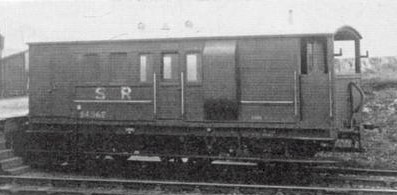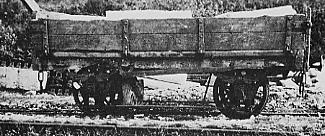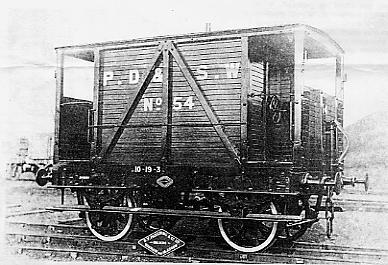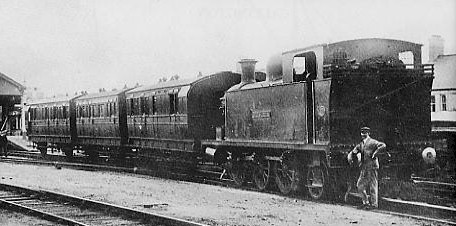| The Callington
Branch Rolling Stock |
|||||||
|
|||||||
This page will describe the goods and passenger rolling-stock used on the former Callington Branch railway line. Please click here for an Index of all Callington Branch pages in RailWest.

6-wheeled Goods Brakevan at
Callington in 1934
The photograph shows ex-L&SWR goods brakevan No 6525, built in June 1906 and intended for use on cattle trains. By the 1930s it could be found (as SR No 54962) on the Callington Branch, where it often carried quarry workers. Later it was used on the Seaton Branch, from where it was withdrawn circa-1959.
East Cornwall Mineral Railway Stock
There appears to be little on record about the rolling-stock of the narrow-gauge (3' 6") ECMR. An article by CR Clinker in the Railway Magazine May 1951 states that, at the time of takeover of the ECMR by the Plymouth, Devonport & South Western Junction Railway (PD&SWJR) in 1891, the ECMR had 126 2-plank and 3-plank open wagons, 16 covered vans, 3 brake vans and 2 'service vehicles'. All the stock had centre combined buffer-couplings and side chains.
 After the conversion and re-gauging of the line in
1908 a few examples of the open wagons remained in use on the internal 3' 6" gauge
system at Kit Hill quarries and one of these is illustrated in this picture.
After the conversion and re-gauging of the line in
1908 a few examples of the open wagons remained in use on the internal 3' 6" gauge
system at Kit Hill quarries and one of these is illustrated in this picture.
To be completed ...
| [Goods] [Passenger] |
The Plymouth, Devonport & South Western Junction Railway (PD&SWJR) 'main line' from Lydford to Devonport was leased to and operated by the London & South Western Railway (L&SWR), using L&SWR stock. The rolling stock described in this section was obtained specifically by Colonel HF Stephens for working the Callington Branch of the PD&SWJR after re-gauging and upgrading to Light Railway status in 1908.
The goods stock was obtained from RY Pickering of Wishaw, near Glasgow, who supplied fifty open and two covered goods wagons purchased second-hand from the Midland Railway (MR) at Derby. The open wagons consisted of 30 3-plank drop-side and 20 5-plank open wagons, which from photographs and dimensions have been confirmed as standard 8-ton MR designs. It is known from Pickering's records that the wagons were numbered from 1 to 50, and it believed (but not confirmed) from the available evidence that the drop-sides were Nos 1-30 and the five-planks Nos 31-50. There were also two covered goods wagons, numbered 51 and 52, and probably these were standard MR vehicles of the offset sliding door type, but no photographs of them are known.
 Pickering also built two new brake-vans to their
general arrangement drawing No. 4439, numbering the vans 53 and 54. These were provided
with vacuum brakes, an unusual feature on a goods brake van at that time, especially as
none of the other goods stock were so equipped. Two possible reasons for this may be the
working (in later years) of L&SWR vacuum-braked vans conveying market produce, or the
working of mixed trains when travelling towards Calstock with the brake van next to the
passenger vehicles, so as to increase the amount of brake power under the control of the
driver. The very low buffer height on these vans probably was the result of Col Stephens
requiring that the wheels and axles be the same as those fitted under the MR wagons.
Pickering also built two new brake-vans to their
general arrangement drawing No. 4439, numbering the vans 53 and 54. These were provided
with vacuum brakes, an unusual feature on a goods brake van at that time, especially as
none of the other goods stock were so equipped. Two possible reasons for this may be the
working (in later years) of L&SWR vacuum-braked vans conveying market produce, or the
working of mixed trains when travelling towards Calstock with the brake van next to the
passenger vehicles, so as to increase the amount of brake power under the control of the
driver. The very low buffer height on these vans probably was the result of Col Stephens
requiring that the wheels and axles be the same as those fitted under the MR wagons.
The wagon stock livery was recorded by Pickering as 'bright red (same as (William) Cory's)'. Ironwork was black with lettering and numbers in white, shaded black on the wagons, but the brake vans had unshaded letters. The lettering was simply PD&SW, the 'J' and 'R' being omitted.
It appears that most of the goods stock was still on the line when it was taken over by the L&SWR in 1922, although one of the covered vans had been scrapped pre-1917 and the other one was never allocated a L&SWR number. Seven of the open wagons also were not re-numbered, the others becoming Nos 01 to 043 in a L&SWR internal list, and some of those survived eventually to become Nos 0238s to 0263s in the Southern Railway (SR) service stock. The two brake vans (53 and 54) apparently never received L&SWR numbers, but were re-numbered by the SR as 56042 and 56043 respectively at Eastleigh in Nov 1925. It is thought that they both remained in use on the Callington branch until they were scrapped, the former in Sep 1928 and the latter in Mar 1930.
The PD&SWJR passenger stock has a rather unclear history. It is known that in Nov 1905 Col Stephens was authorised to buy an unspecified number of coaches from the L&SWR, and indeed there are a few photographs showing ex-L&SWR 4-wheeled coaches of 1879-85 vintage on the line in early days. It has been said that the PD&SWJR also purchased some ex-North London Railway stock , but no evidence for this appears to exist. Official returns show 16 coaches in 1910, 9 in 1911 and 8 in 1913. In 1921 the remaining 4-wheel coaches were replaced by second-hand bogie stock bought from the L&SWR for £500 (a price which included overhaul and renovation). It was reported in later years that the passenger coaches were painted dark green.

Ex-L&SWR 4-wheeled
coaches at Callington circa-1910
To be completed ...
To be completed ...
To be completed ...
© Chris Osment 2003